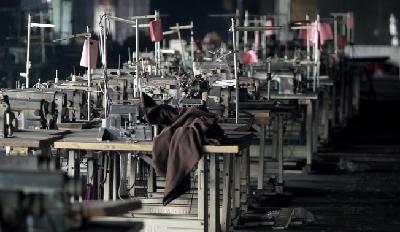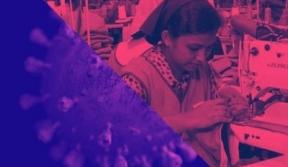
When customers at the U.K. clothing brand Primark check the labels of its garments, they usually expect to see low, low prices: £6.00 for a T-shirt or £10 for a dress (approximately $10 or $20, respectively). But last month, shoppers at locations in Belfast and South Wales reportedly found labels sewn into clothing that appeared to be cries for help, with stitching that said, “Degrading sweatshop conditions” and "Forced to work exhausting hours.”
After investigating the matter, Primark has claimed that the labels were a hoax. Nevertheless, the incident brought back into the headlines an issue that has long dogged the apparel industry: the working conditions in its factories based in impoverished communities across the globe. In April 2013, these conditions became the subject of international scrutiny when more than 1,100 workers in the Bangladesh factory Rana Plaza died when the building collapsed. The incident came on the heels of another factory disaster, also in Bangladesh, when in late 2012 more than 100 employees died in a fire at the Tazreen factory.
These and other tragedies have focused the world’s attention on the human cost of the so-called "fast fashion" industry, which is known for getting fashion’s latest trends to the mass market with a quick turnaround and at bargain prices. But solutions are hard to come by, largely because of the complexity of the supply chains piecing together these garments.
“What you’ll find is that the retailers don’t often have a lot of direct, day-to-day contact with all these factories,” says Elizabeth Cline, author of “Overdressed: The Shockingly High Cost of Cheap Fashion.”
Major retailers often depend on the factories they work with – sometimes numbering in the hundreds for a single company – to do the sourcing of the materials down the line, which, in addition to the fabrics, includes buttons, zippers, beading and the other pieces added to garments. Sometimes clothing companies don’t even work with factories directly, instead relying on a middleman agent to contract out the manufacturing.
“That in and of itself means that the buyer doesn’t know anything at all about who is making their product,” says Marsha Dickson, professor of fashion and apparel studies at the University of Delaware.
Furthermore, when compared to other global industries, garment production is extremely mobile. The fashion industry is always looking for the next country with the lowest wages to move their operations. For instance, Gap is exploring becoming the first major U.S. apparel retailer to make a footprint in Myanmar, while H&M expands its production to Ethiopia.
“Manufacturers have tended to be at the short of end of the stick when it comes to the power relationship,” Dickson says, and that means if there are labor issues in their factories, it's on the factory owners and not the retailers to pay for fixing it.
“The fashion industry has designed a system that allows companies to easily move from country to country, from continent to continent, whenever there is an opportunity to cut costs," says a Democratic staffer with the U.S. House Education and the Workforce Committee, who has worked on legislation addressing issues in supply chains of retailers. "Factories in the supply chain are pressured by this global race to the bottom, and, to remain competitive, far too often compromise basic labor rights by abiding poor health and safety conditions, engaging in wage theft, and in violent repression of unions.”
The minimum wage in the Bangladesh garment industry, for example, is equal to about $68 a month.
How to get retailers involved in fixing the conditions that led to the Bangladesh accidents was a major question raised in their aftermath, and the two coalitions that have since arisen in response take different approaches. The initial effort, the Bangladesh Accord for Fire and Building Safety, was formed by European brands like H&M, Carrefour and Mango, but also includes 16 American companies among its 150-plus members. However, some of the largest American brands, such as Wal-Mart, Gap, Target and Kohl’s, refused to sign on and formed their own committee, the Alliance for Bangladesh Worker Safety, whose 26 members are either American or Canadian.
Workers’ rights activists tend to favor the Accord, which is legally binding, and includes labor organizations and workers’ representatives in its stakeholders. Meanwhile the Alliance is a nonbinding, unilateral effort that asks members to donate to a pool to cover wages of workers whose factories are temporarily closed after inspections and to fund low-interest loans to factory owners to make repairs.
Recent reports by The New York Times and Reuters have found that both groups have fallen short on their promises to inspect and oversee repairs to Bangladesh’s nearly 2,000 factories – which employ some 2 million workers, by some estimations.
Part of the problem, these investigations have found, is the corruption underlying Bangladesh’s political system. It is ultimately up to the government to shut down factories that have failed inspections – and local authorities have their reasons to keep the factories running.
“If [retailers] simply pull out because of the risk, they can cause more harm than good in local communities” says Karen Stauss, director of programs at Free the Slaves, an international anti-slavery group. She says it’s better that retailers take a more “surgical approach” – meaning that they work with factory owners to fix the specific labor and safety problems rather than end their relationships with the factory owners entirely.
Nevertheless, labor activists say governments have a role to play in policing the supply chains in fashion and other industries.
“Government commitment is key wherever companies have been successful, because they won’t do it without the government with them,” says Brian Campbell, director of policy and legal programs at the International Labor Rights Forum.
The most recent U.S. legislative attempt to address human rights issues in global supply chains camelast month in a proposal sponsored by Rep. Carolyn Maloney, D-N.Y. Her bill, the Business Supply Chain Transparency on Trafficking and Slavery Act, is similar to a recent California law that requires retailers and manufacturers grossing at least $100 million annually and do business in the state to disclose the efforts being made to eradicate human trafficking in their direct supply chains. The federal version would require companies to include this information on their SEC reports, similar to provisions in the 2010 financial industry legislation known as the Dodd-Frank Act, which requires companies to report to the SEC the use of conflict minerals in their products.
On the surface level, the measure is very modest. It requires only that companies report the efforts they’re making to identify, prevent and remediate human trafficking in their supply chains. It does not force companies to take any particular actions.
"This is a consumer right-to-know bill. As consumers we all have the right to know that we are not buying slavery-tainted toys, clothes or other items off the shelf. We can then decide whether or not to take our business elsewhere if a company refuses to take slavery seriously," Rep. Chris Smith, R-N.J., a supporter of the bill, said to U.S. News in an emailed statement.
It does not require the companies to be transparent about the supply chains themselves, though some large brands like Nikeand Adidas now are, in part because of lobbying done by the college community.
“In our view, transparency means that you disclose where your products are being produced in a way that lets independent third parties look into the conditions of those factories, whether the claims you're making are accurate or not,” says Ben Hensler, general counsel to the Worker Rights Consortium, which has worked on efforts to bring transparency to major retailers that license college athletic logos.
Even still, the bill with bipartisan support, already faces opposition from the fashion industry.
“The goal, we absolutely agree with, and there’s no company that supports human trafficking or forced labor,” says Julia Hughes, president of the United States Fashion Industry Association. But in terms of addressing supply-line concerns, “it isn’t going to accomplish what [Maloney] wants to accomplish.”
Hughes' and other trade groups oppose the legislation not only because it will take a state law nationwide, but it will also extend its reach much further down the line: the California law is concerned with measures being taken at the top-tier of the supply chain, industry representatives say, while the federal bill asks for actions being taken every step of the way. Additionally, it expands its scope to include the “worst forms of child labor,” an International Labor Organization term that the industry says will cause added confusion.
Like opponents to the conflict mineral legislation disclosure requirement, the apparel industry also questions whether the SEC is the appropriate government entity to be dealing in human trafficking.
“That [is] just not their thing. They deal with banks. They deal with the financial service industry. They’re not equipped to deal with that,” says Nate Herman, vice president of international trade at the American Apparel and Footwear Association.
A letter the sent to Maloney last December ahead of the bill’s introduction and signed by Herman's and Hughes' organizations, as well the National Retail Federation and the Retail Industry Leaders Association, pointed to a speech made by SEC Chairwoman Mary Jo White at Fordham Law School in October. In it, White questioned using federal securities laws that “seem more directed at exerting societal pressure on companies to change behavior, rather than to disclose financial information that primarily informs investment decisions.”
Herman adds, “The SEC isn’t the type of organization that is created to monitor ethical sourcing policies in companies or exactly the right place to have that kind of dialogue.”
Labor advocates counter that investors deserve the right to know what measures companies are taking to root out human trafficking in their supply chains as – moral obligations aside – such issues pose a financial, reputational and fiduciary risk to the companies’ bottom lines.
“Knowing that a company itself is exposed to these types of risks is really, really crucial to investors’ ability to simulate and manage their own investment portfolios,” says Sara Blackwell, a legal and policy associate at the International Corporate Accountability Roundtable. She points to the South African divestment movement in the 1970s and 1980s in response to apartheid as an example of “the role of investment contributing to respect for human rights for many years, if not decades.”
Furthermore, activists say, SEC transparency laws are effective at changing an industry, particularly when looking at the precedent set by the Dodd-Frank conflict mineral provision.
“Once the legislation was introduced, I feel like it’s been a bullet train,” says Patricia Jurewicz, founder and director of the Responsible Sourcing Network, an organization concerned with human rights abuses in raw material sourcing. She praises the Dodd-Frank legislation for prompting “the fast pace at which companies have been proactive in establishing systems and policies," as well as for having pulled "together as an industry – at least in the IT sector – to have more transparency and accountability in their supply chains.”
But it's likely industry groups would be opposed to any sort of government intervention, even measures not reliant on the SEC.
“It’s hard to see where the government regulations piece would come in,” Hughes, of USFIA, says.
AAFA's Herman adds, “I think we’ve been able to make a lot of progress without government involvement.”
And industry groups are willing to put up a fight.
A provision in a defense-spending bill last year that required exchange stores on military bases to give preference to retailers who had signed on to the Bangladesh Accord passed quietly in the House in June before being blocked in the Senate. According to a Huffington Post report on the measure’s demise, retailing and clothing lobbyists were able to turn lawmakers against it by arguing that it would prop up a supposedly European effort at the cost of undermining the American initiative.
Those pushing the supply-chain legislation say the key to moving it forward is to get some major companies to champion the program, which will be no easy task, even if the bill seems to be a deceptively modest measure.
“You have to be really comfortable with where you are in your program – what you’re doing and the efforts you're making – and have the confidence to say, 'We know we still have a lot to do,'” says University of Delaware's Dickson. “I don’t think a lot of companies are very confident, putting themselves in front of stakeholders.”
And at the end of the day the initiatives – whether specifically aimed at factory safety in Bangladesh or transparency laws that only look at the issue of human trafficking in supply chains – are only piecemeal efforts that may not get at the heart of the issue.
“The issue of trafficking and the issue of poor working conditions really become muddled,” says Campbell, of the International Labor Rights Forum. “When you are looking at a situation of extreme poverty – which largely is what garment workers are in a lot of these countries – you are tripping across issues related to debt structures of families, how they get their jobs, how they’re transported into the business and that’s going to vary by the company.”



